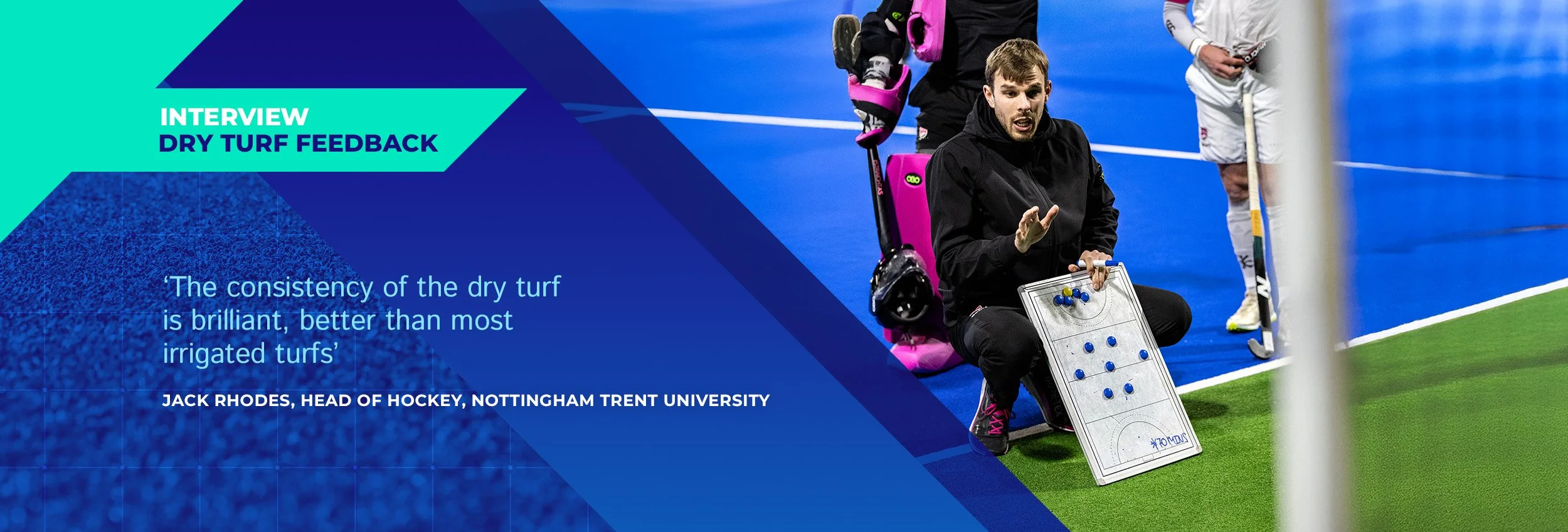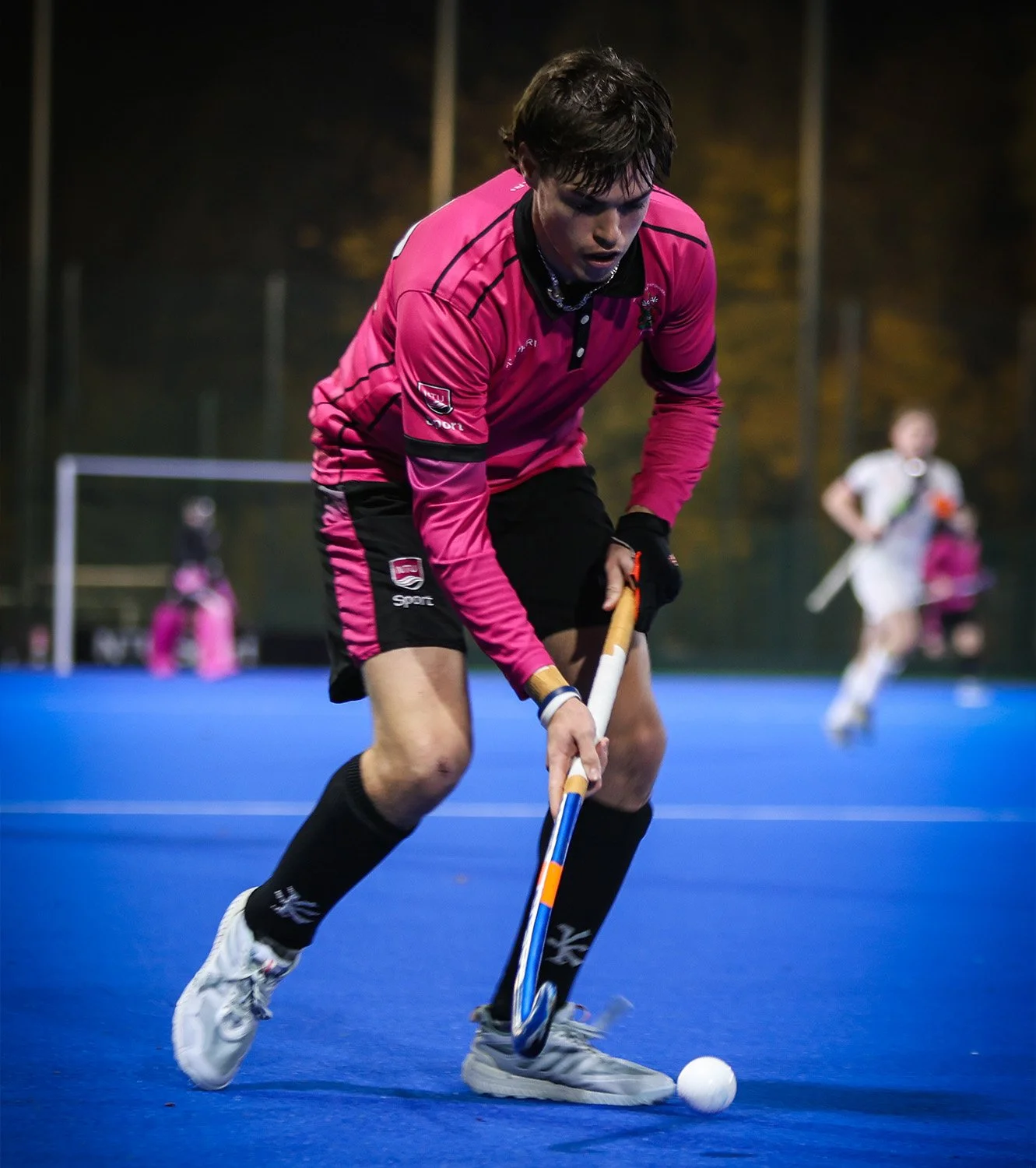Interview: Jack Rhodes, Head of Hockey, Nottingham Trent University
The former England and Wales international player-turned-coach rates the Poligras Paris GT zero turf.
Jack Rhodes is a former international player, who spent his formative years in England junior teams and progressed into the Welsh senior team. He has now made the leap to full time professional coaching at Nottingham Trent University (NTU) where he has been the Head of Hockey since 2023. NTU upgraded from a sand surface to a Poligras Paris GT zero turf in the summer of 2024. We caught up with him a year on to find out how it is playing and what difference it has made from a sport, sustainability and player safety point of view.
What brought you to NTU and what does your role involve?
I had success at a national level as a youth player with some great university and club competition thrown in, including multiple European and Senior Cup victories. When it was time to hang up the playing boots, I made the move into coaching and was attracted to NTU for its quality and size. We have many senior and junior internationals including six alumni who play for England. I started as the Performance Hockey Coach in 2022 and was promoted to Head of Hockey where I oversee one of the biggest university hockey programs – 300 students, six men’s and six women’s teams.
“There has been a 90% drop in physical (v impact) injuries because of the consistency and the responsiveness of the turf.”
What was the catalyst for the university’s turf upgrade?
We were previously playing on an old sand hockey turf which was probably 10 years old so had became very slow and slippery, which is dangerous. So we knew an upgrade was due but sustainability, as well as performance, was a key decision-making factor.
NTU wants to be the most sustainable university in the world, so right from the get go, we knew we didn’t want to install an irrigation system. The Paris turf was the best non-irrigated option we found and was installed in the summer of 2024 ready for the start of the season in September. This was perfect timing and the installation went very smoothly.
Where is the pitch situated and does this impact how it plays?
The turf is located near a river which means there is plenty of dew and the climate is mild with regular natural moisture. It is also on lower ground at the university which means it is slightly sheltered from the wind and doesn’t have any shade.
This means that most of the time it isn’t played when fully dry. We have not yet used it for pre-season during the summer so this year will be a good test of how it plays during the dry, warmer pre-season spells. But within weeks of playing on the surface, whether it was dry, wet or damp the performance lift was really noticeable.
What are the standout features of the new turf?
What has particularly stood out has been how good the turf is for player movement. Its responsiveness when players change direction is excellent, perhaps the best I have ever experienced. With hockey becoming more and more athletic and quicker this has been a great benefit.
What differences do you notice with the play wet / play dry crossover performance?
90% of the time, the turf plays brilliantly. The other 10% of the time when it is warmer and dryer (this was the case for us in September and April), I’d give it a nine out of ten.
During this 10% of the time, the players may need to adjust some of their skills to manage the increase in friction. This applies to slap hitting and corner injection and also to some larger dribble movements. When dry, the ball does bobble a little bit more but this does not have much impact.
“If I could wave a magic wand, I would change all hockey surfaces to the one that we now have.”
How consistent have you found the Paris turf?
The consistency of the turf is brilliant and better than most irrigated turfs in my experience. This is because the turf performs consistently across the whole surface, whereas irrigated turfs tend to dry out at different rates across the surface and the irrigation systems don’t always provide uniform coverage. This patchiness creates inconsistency. The Paris surface, whether it is wet from rain, damp from dew, or dry, the whole turf plays consistently.
We’ve also noticed that when this turf has some moisture in it, it holds its performance for longer than an irrigated turf. Irrigated turfs drop off in performance which is why they are often re-watered at half time.
During drier weather, the Paris turf plays very well in the morning, performance drops off from around noon until 2:00pm, and then steadily improves during the afternoon through to evening. Even when dry and the friction has increased a bit, it is consistent across the whole turf and maintains its peak performance for longer.
Have you adapted the equipment you use?
We are testing various balls – smooth and dimpled. When the turf is dry, I think the ball weight is the most important feature, with heavier balls working better. We haven’t made a change in footwear because the turf is soft, reactive and responsive which is amazing for player movement.
It would be good to see some development with the goalkeeping pads. When the turf is dry, the goalkeepers need to make some small adjustments as they do not slide across the turf as well.
What difference has the turf made to NTU’s hockey program?
We’ve become doubly sustainable - we now have a great turf to keep our player performance sustainable and we are environmentally sustainable.
And we’ve seen a massive decrease in the amount of injuries. There has been a 90% drop in physical (v impact) injuries because of the consistency and the responsiveness of the turf. The players can trust the turf because they know it will be consistent over time and across the full field.
What would you say to other hockey facilities looking to make a turf change?
If I could wave a magic wand, I would change all hockey surfaces to the one that we now have.





